1. The Need for Decentralized Social Networks

What You’ll Uncover in This Chapter
- Can DeSoc compete with Web2 giants? Examine if platforms like Farcaster and Lens can rival Facebook and TikTok.
- How is Web2 embracing Web3? Learn from successes and failures in integrating blockchain features like NFTs and tokenized communities.
- What sets Discord and Telegram apart? See how these platforms bridge Web3 functionality with massive user bases.
- What’s the future of social media? Discover how hybrid and fully decentralized models shape tomorrow’s digital interactions.
X (formerly Twitter) was shot down in Brazil. Telegram’s CEO Pavel Durov faces legal challenges in France in 2024. These incidents underscore a recurring issue with centralized social media platforms: users and creators are vulnerable to platform decisions and external pressures, such as government interventions.
At the time of writing this report, it’s still open whether X will be reinstated later and Telegram’s CEO will be released. However, for everyone whose careers are tied to centralized platforms, the final outcome matters little. If you belong to this group, you understand the impact and risk such temporary disruptions pose to your ability to generate revenue. They could even threaten your very existence as an online business.
Creators, vendors, publishers—in short, all types of businesses—and users are vulnerable to shifts in policies, content moderation decisions, or legal rulings. You are left with little recourse and minimal control over your digital assets. It only takes a single decision from a platform executive or a government authority to deliver a fatal blow to the livelihoods of millions.
Yet censorship is just one of the cracks in the centralized social media foundation. Another significant issue is revenue imbalance. While platforms like Meta and YouTube generate billions, creators receive only a tiny fraction, even though they fuel and populate the platforms.
The social media crossroads
In the 21st century, social media has evolved from a simple novelty into a global force, fundamentally altering how we communicate, share information, and conduct business. With more than 5.07 billion users — approximately 62.6% of the global population engaging daily on platforms like Facebook, Instagram, YouTube, and TikTok, social media networks have become an essential part of our lives. It’s not just a tool for connection; it’s a powerful economic engine projected to generate $251.45 billion in revenue (including paid ads, subscriptions, and data licensing) by the end of 2024. The social media advertising market alone is expected to reach $226.73 billion (from paid ads) in the same year. But as these networks grow, the rift in their groundwork becomes hard to ignore.
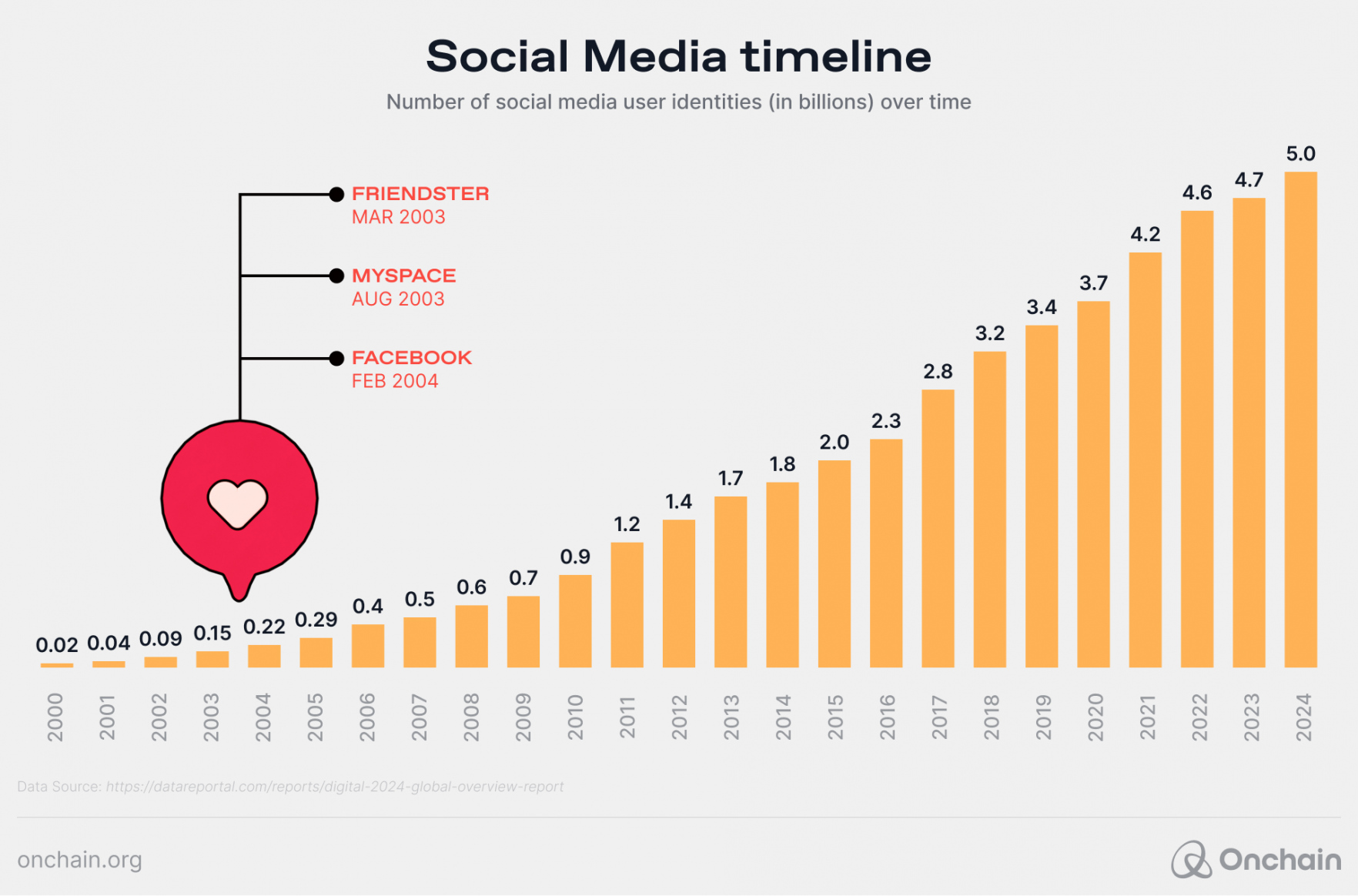
1.1 The cracks in the foundation: What’s wrong with today’s social media networks?
The incredible growth of social media has come at a cost:
- Centralized control: Dominant platforms decide what content is seen and what is hidden, wielding significant influence over public discourse and personal expression.
- Censorship and content manipulation: Meta or YouTube has the power to suppress or promote content based on their agendas, often stifling free speech and limiting the diversity of viewpoints.
- Erosion of privacy: User data has become the currency of the internet, with personal information being harvested and sold, often without the user’s knowledge or consent.
These concerns were echoed in our survey, where participants highlighted similar frustrations with today’s social media platforms.
We questioned 410 participants within the DeSoc domain regarding the current challenges of traditional media and motivations for emerging DeSoc platforms. These participants are demographically diverse avid users of social media platforms.
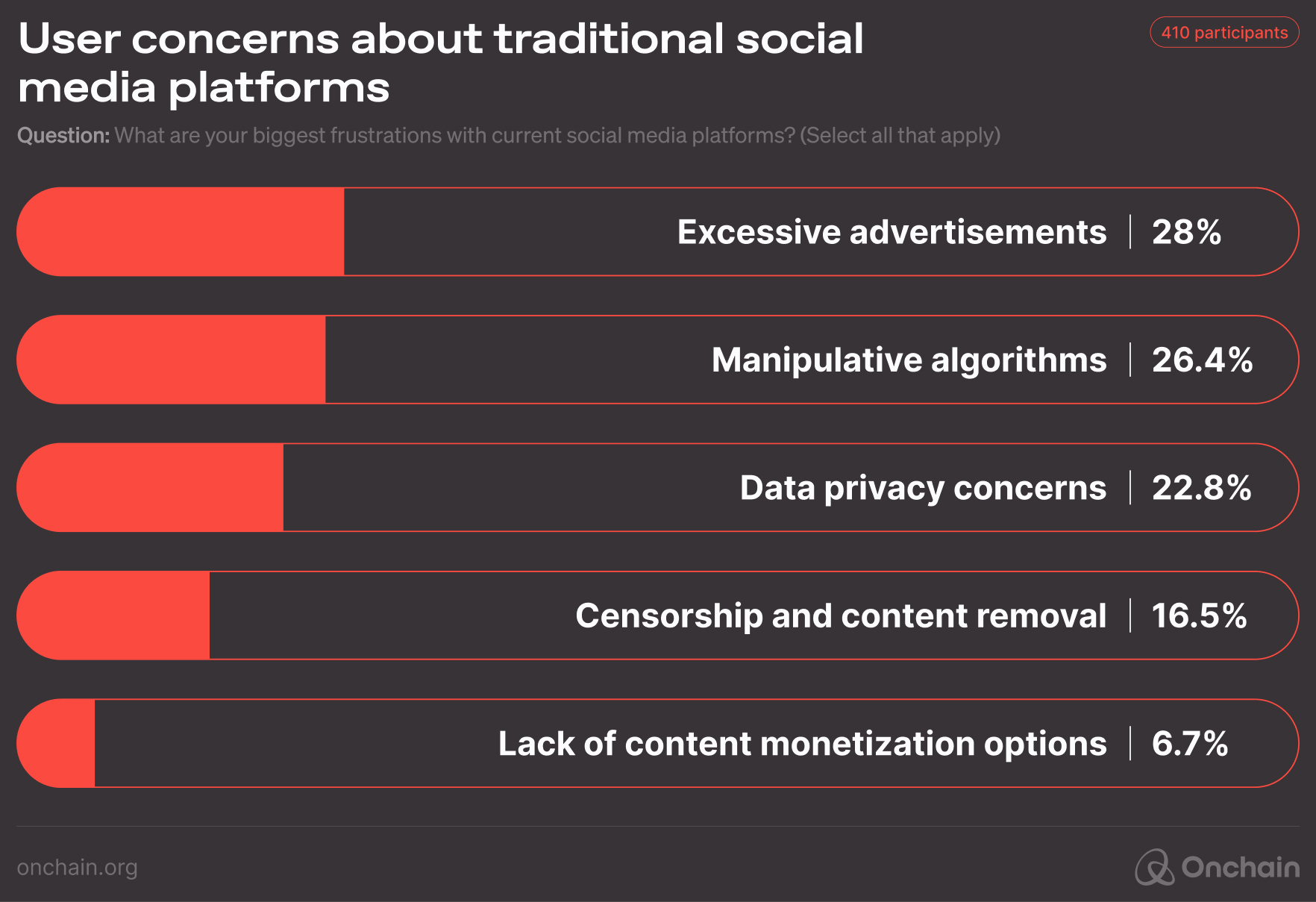
Unequal revenue distribution: Here’s what it looks like in numbers:
- Meta (Facebook, Instagram) & TikTok: The effective take rate can be up to 100%, meaning creators are essentially left with no direct revenue share at all. This makes Meta one of the highest take-rate platforms among Web2 giants.
- YouTube: Typically, YouTube’s standard revenue-sharing model is a 55/45 split, where creators receive 55% of ad revenue, while YouTube takes 45%. However, these rates can vary depending on the niche or the specific contract a creator has with YouTube, which can often further reduce earnings for creators, depending on which niche their content focuses on.
- Twitch: Recent data showed that the top 1% of streamers earned over half of the platform’s total revenue, while most streamers earned less than $120 annually. You may want to read that again to grasp the magnitude of the discrepancy.
- Music streaming platforms: Over 8 million musicians use services like Spotify, but only 15,000 of them earn more than $50,000 per year. The platforms and record labels retain most of the revenue.
Source: A16z, https://x.com/cdixon/status/1425645851599273985
Needless to say, with such take rates, it’s increasingly difficult for creators to make a living. Studies show that:
- Only 10% of content creators on YouTube earn over $100,000 annually.
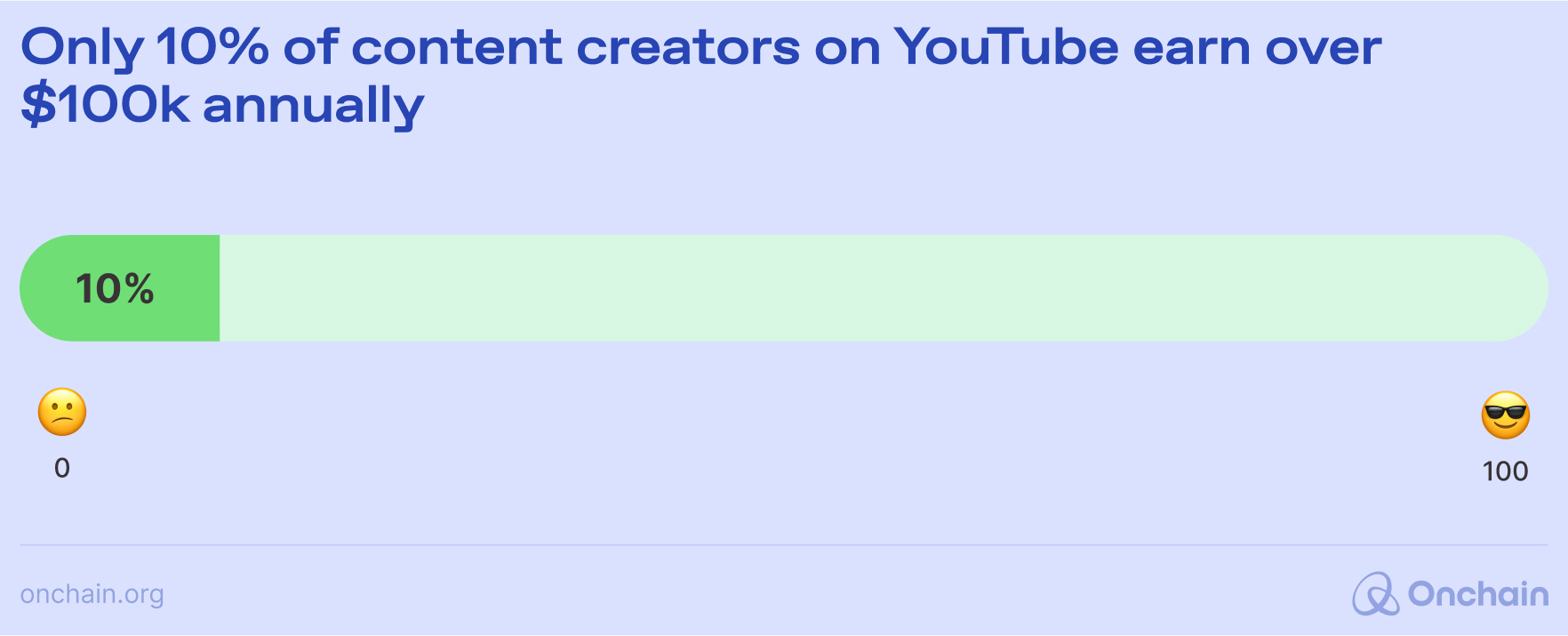
- It takes creators an average of 17 months to start earning a sustainable income.
- 51% of full-time content creators earn enough to support at least one person, while 36% earn some income but not enough to cover their basic expenses.
- There is a significant gender pay gap in the creator economy, with male creators earning, on average, 1.88 times more than their female counterparts.
The ripple effects: Holding back the digital economy
These imbalances have far-reaching consequences for the entire digital economy. The current structure of Web2 social media platforms limits growth and innovation by concentrating wealth at the top. This system prevents the creator economy from reaching its full potential. The majority of creators are left with insufficient resources to scale their businesses, experiment with new content formats, or engage more deeply with their audiences.
Take a look at the stark difference between Web2 and Web3 platforms:
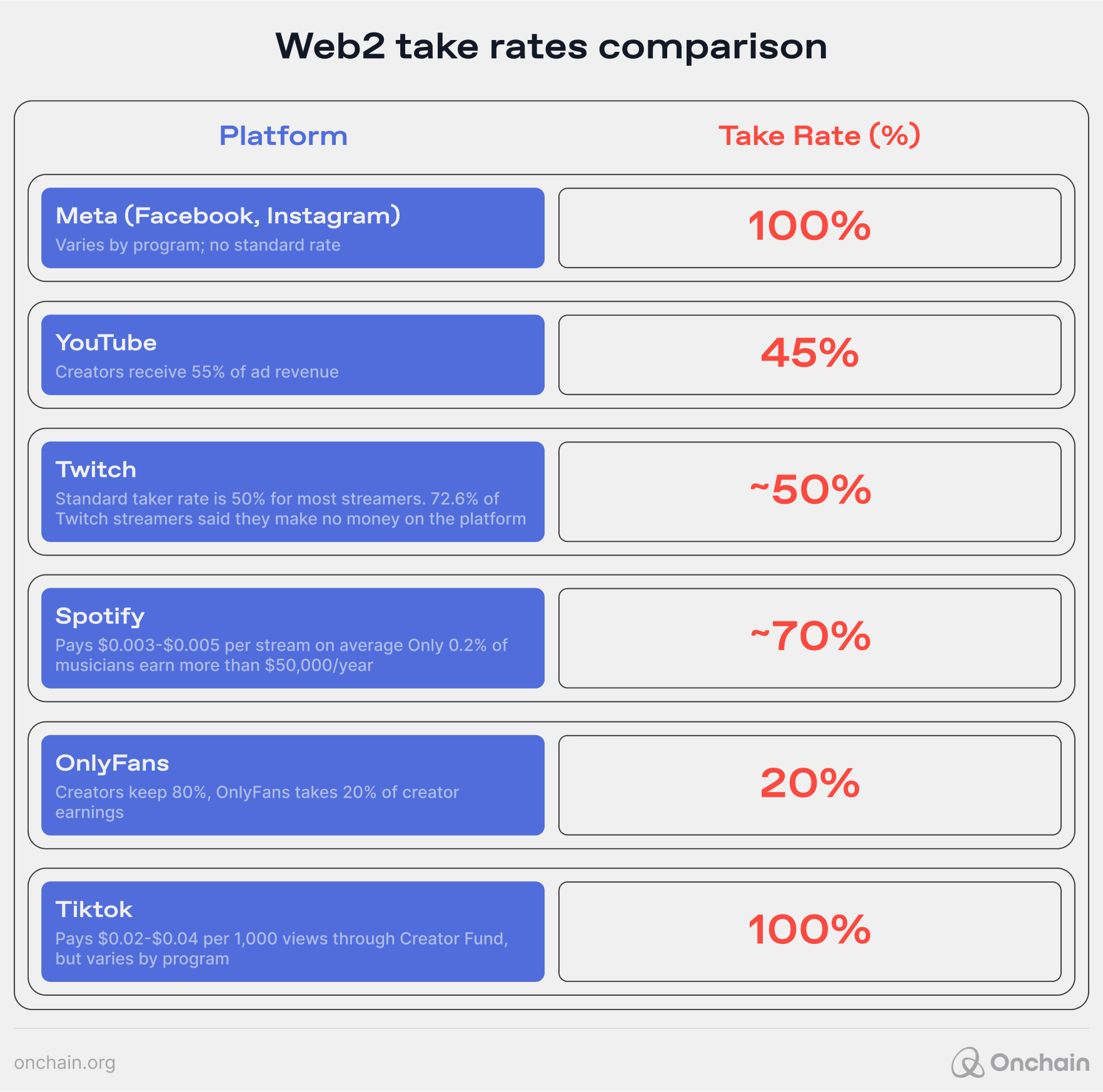
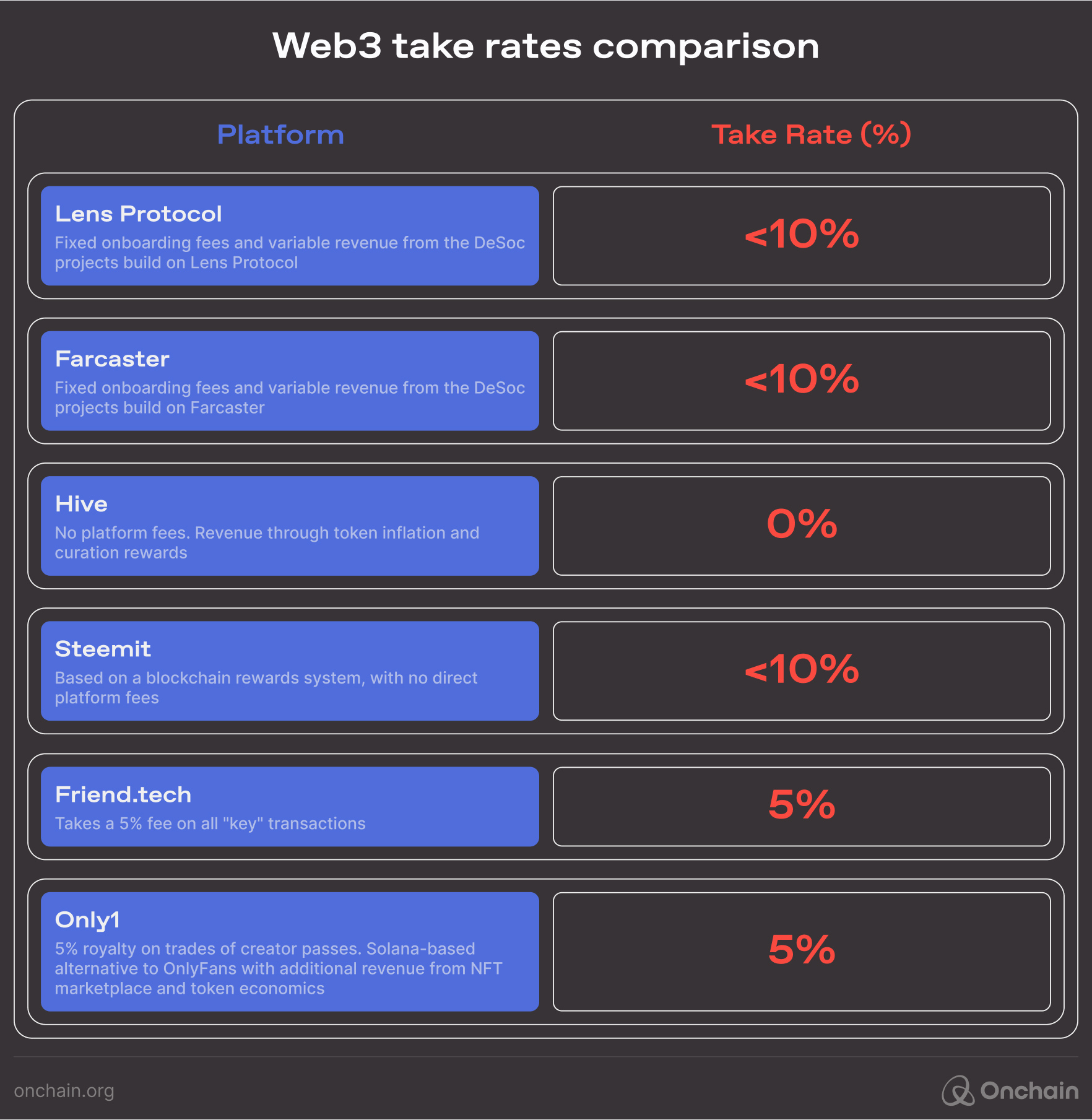
“The current social media landscape, with its high taker rates limits the creator economy’s full potential by concentrating wealth at the top. Decentralized social networks could break these constraints and help the creator economy to reach its next level.” — Leon Waidmann, Head of Research at Onchain
1.2 A glimpse into the future of social media
In response to the deep-rooted issues plaguing today’s social media landscape, decentralized solutions are emerging as a promising alternative. These platforms, often referred to as DeSoc (Decentralized Social) networks, are carving out a path toward a more equitable and user-focused digital ecosystem.
DeSoc networks, such as Lens, BlueSky, and Farcaster, offer a fundamentally different experience. They leverage blockchain technology to return data, identity, and content ownership to users. The users are no longer at the mercy of platform owners; instead, they enjoy control, transparency, and security.
The paradigm shift is no longer mere theory; it’s happening. Now you’ll want to know how (otherwise you wouldn’t be here).
We’ll start with a few examples and then get into the nitty-gritty. On Lens, users can mint posts as NFTs, proving ownership and enabling new forms of monetization.
Farcaster allows seamless transitions across apps while preserving your digital identity.
BlueSky lets you choose the algorithms that determine your feed, giving you control over content discovery.
Naturally, DeSoc platforms face challenges — scaling, user adoption, and maintaining user experience. However, the networks in our examples are fully operational and growing. They provide a sense of how the future of social media might look and feel.
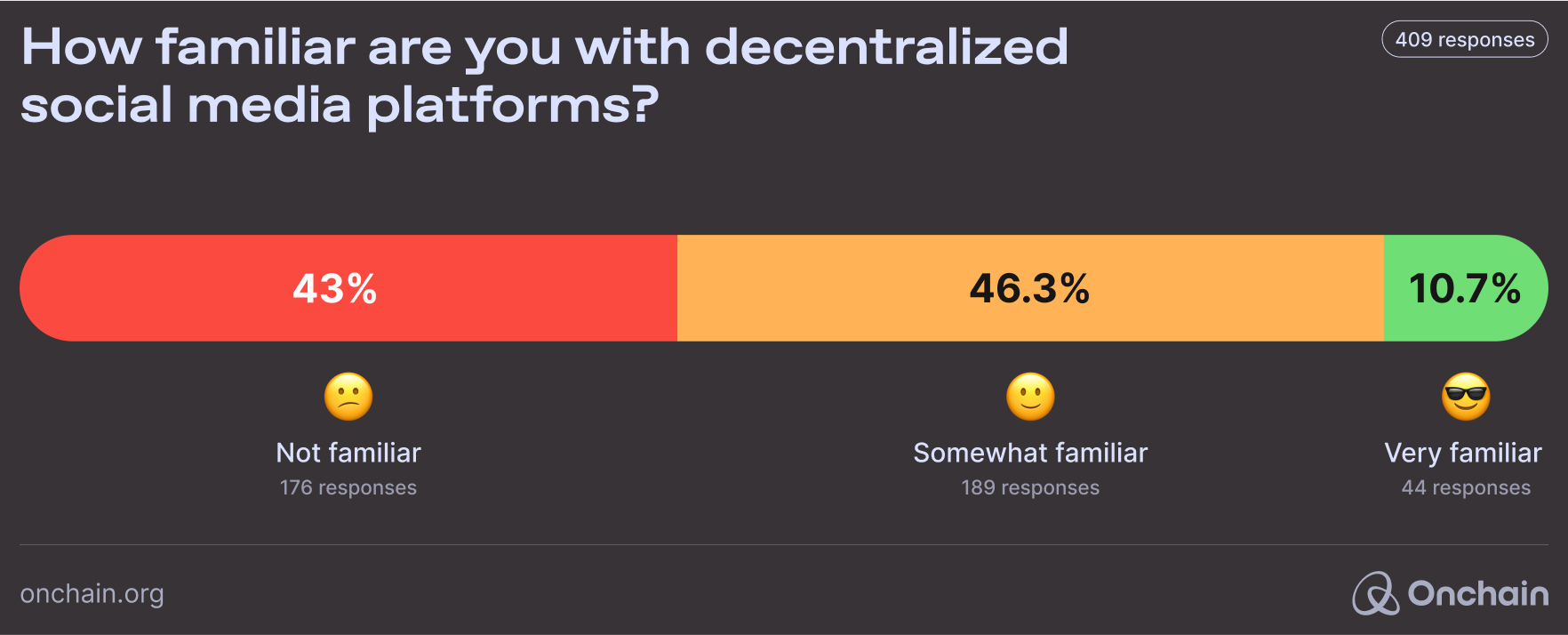
Farcaster and Warpcast: A new social media paradigm
Farcaster is one of the trailblazing protocols in the DeSoc space, with Warpcast as its leading application. Warpcast represents a new standard in how we interact online.
In traditional social media (TradSoc), platforms dictate the user experience and decide who sees what and how data is monetized. Warpcast flips this model on its head. By leveraging blockchain technology, users are empowered to own their digital presence. Your identity, connections, and content are yours to control, transfer, and protect.

Sponsored content by Optimism
The Optimism Superchain Ecosystem: Scalable infrastructure for DeSoc
The Optimism Collective is a community building decentralized infrastructure to scale Ethereum. The OP Stack is its open-source software, used to create scalable Layer 2 chains like Base, Lisk, Mode, and Sonieum. The Superchain connects these chains for shared security and seamless interoperability. For example, DeSoc projects like Farcaster, and Zora are built on Chains utilizing the OP Stack, making them part of the Optimism Superchain Ecosystem.
User accounts on decentralized social networks can be secured by The OP stack, which is further secured by Ethereum L1. This gives each user’s social profile more resiliency against deplatforming and thus surcharge free speech, the way one can view this is shown in the following diagram:
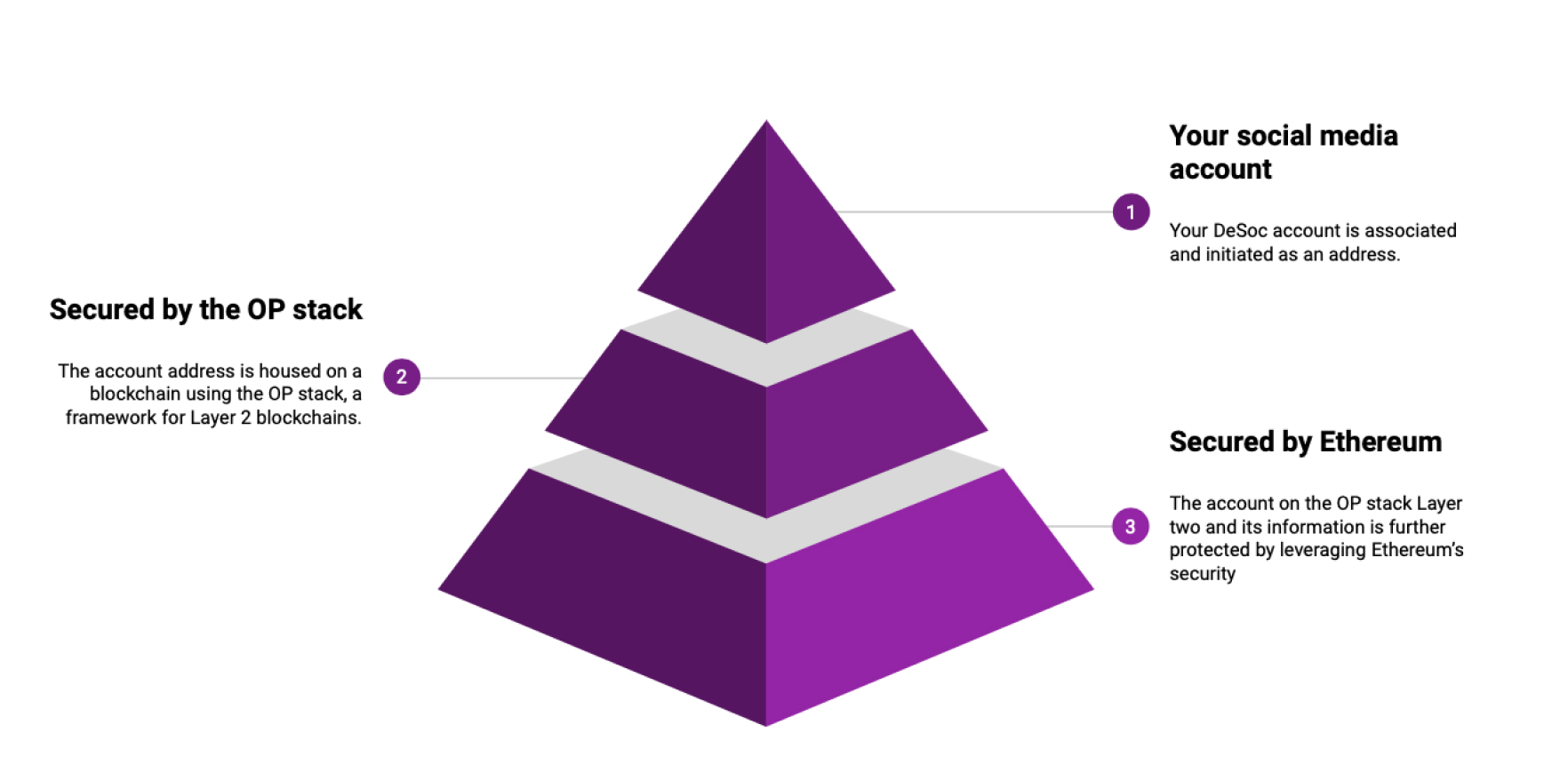
Furthermore, because DeSoc platforms allow for multiple clients (front-ends) through which you can access your account, a user has free-choice to use whichever interface they like best without needing to start a whole new account – this creates a more flexible social media where the user can choose their own experience from a myriad of options versus be siloed and locked in on one interface.
In the following section, we’ll take a closer look at Warpcast’s features. You’ll understand why Warpcast is not just an alternative but a great example of what makes DeSoc unique.
1.3 Highlighting Warpcast’s coolest features
1. Payments: Direct and decentralized
Features: Paybot & Payflow
- What they are: Paybot and Payflow allow users to send and receive payments directly within Warpcast, enabling seamless, peer-to-peer (P2P) transactions.
- Why they matter: On Web2 platforms, monetization involves a middleman, whether through ad revenue, sponsorship deals, or third-party payment services. As a result, creators may only receive a fraction of the income they generate, with the platforms taking a significant cut. Warpcast changes this dynamic. Here, if you appreciate a post, you can instantly send a payment or tip to the creator without intermediaries, putting the power back in the hands of users and creators and ensuring more direct, transparent, and fair compensation.
Example: Imagine stumbling upon a valuable piece of Web3 analysis on Warpcast. Instead of just liking it, you can instantly tip the creator in USDC, rewarding them directly for their insights and encouraging more high-quality content.
Our survey results confirm strong user interest in tipping on social media. 54.5% of respondents are ‘possibly willing’ and 16.2% are ‘definitely willing’ to support creators. This shows a clear demand for features like direct payments, which empower users to reward creators directly for valuable content.
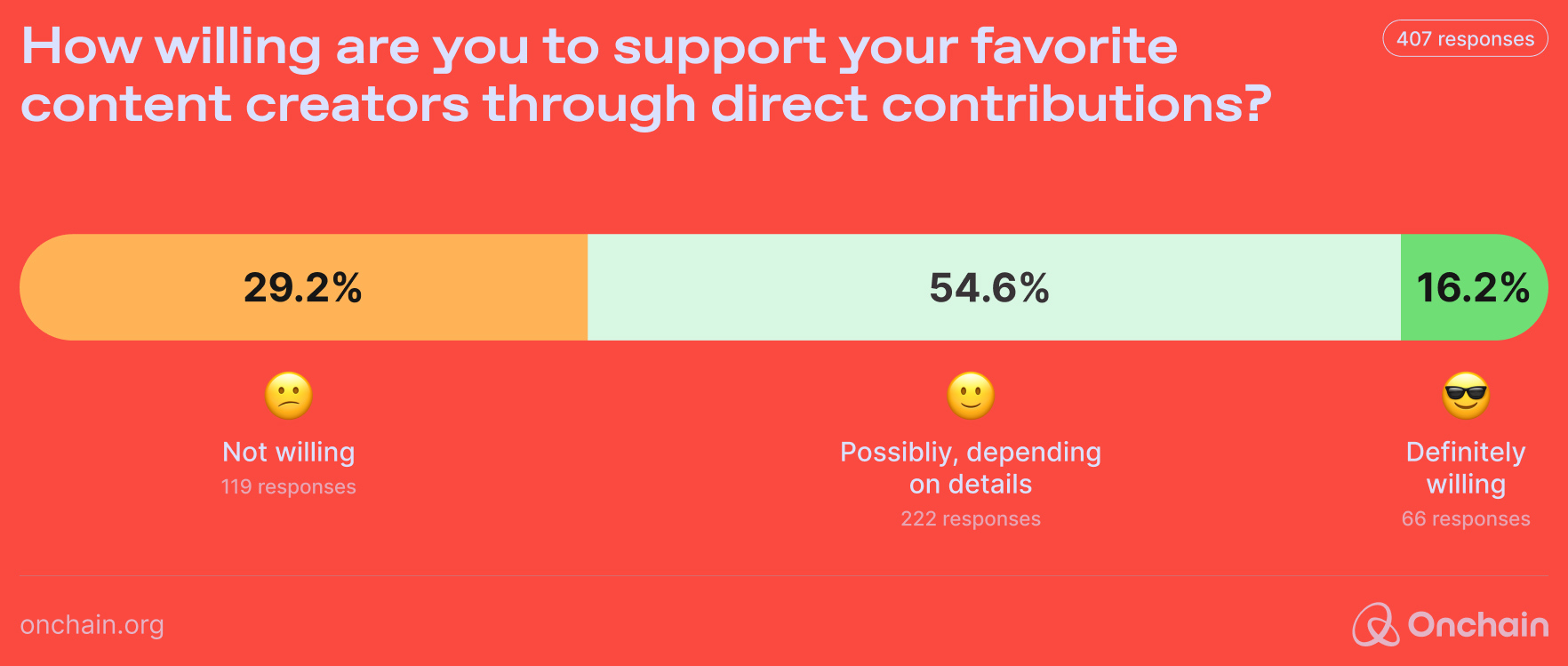
2. Data for sale: Monetizing your insights
Feature: Data for sale
- What it is: Farcaster’s “Data for Sale” feature allows users to sell text-based content for USDC. Users set a price, create the content, and share a link for others to purchase directly, with payments going straight to their Farcaster wallet.
- Why it matters: This feature empowers creators to monetize their expertise directly, cutting out intermediaries. It’s a game-changer for Web3 enthusiasts, allowing them to directly sell valuable insights, such as trading tips or exclusive investment strategies, to their followers.
Example: Picture a Web3 analyst offering an exclusive tip on an upcoming altcoin surge. Followers can buy this insight directly from the analyst, gaining an edge in the market while directly supporting the creator.
3. Crowdfunding: Empowering communities and projects
Feature: Crowdfund
- What it is: Warpcast allows users to create and support crowdfunding campaigns directly within the platform, facilitating community-driven projects and initiatives.
- Why it matters: On traditional Web2 platforms, crowdfunding relies on separate payment systems like Meta Pay for Facebook. This adds extra steps and creates a fragmented experience that can vary by country. Warpcast, in contrast, is built on a unified blockchain foundation (BASE), where crowdfunding features can be natively integrated. This allows users to launch and support campaigns seamlessly without needing to switch to external payment systems. The result is a more straightforward, consistent process that gives users greater control over their campaigns and funds.
Example: Imagine you’re developing a new decentralized app. Instead of navigating multiple platforms and payment processors, you can start a crowdfunding campaign directly on Warpcast. By leveraging your social connections within the platform, you can build momentum and secure funding all in one place without the need for external tools or systems.
Now you understand why the chances are low that social media networks will remain as they are. Users demand privacy and security, and creators and companies push for control and a fair revenue share. However, centralized platforms are not dormant. Many are well aware that they need to adapt if they want to keep their position as market leaders.
In the next chapter, we’ll explore how social media giants have tried to integrate Web3 features. You’ll learn which features gained traction on which platforms and which ones weren’t fruitful. But what’s probably more interesting for you is to understand why features succeeded, how the platforms integrated them, and who they attract.